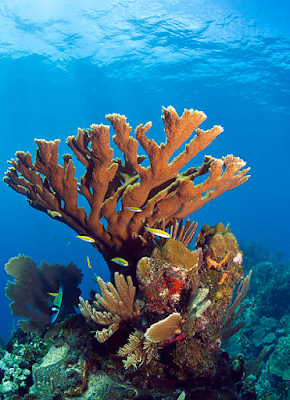Endangered Species: Elkhorn Coral
Elkhorn Coral is currently listed as critically endangered on the IUCN Red List. These coral colonies are tan or brown with white tips, a color that comes from the algae that lives in Elkhorn Coral Tissue. This photosynthetic algae, called zooxanthellae, also provides the coral with food and oxygen. In return, the coral provides the algae with protection, nutrients, and carbon dioxide. Additionally, the polyps will capture plankton in their tentacles to obtain food. The coral has several natural predator species that graze on polyps, including damselfish, fireworms, and corrallivorous snails. The polyps have limited defenses against these predators. According to Animal Diversity Web, their defenses include the polyps ability to react to touch and release venomous nematocytes into the water. The National Oceanic and Atmospheric Administration of the US Department of Commerce estimates that this species of coral grows to about twelve feet in diameter, six feet in height, two inches thick, and hundreds of years in age. They can live anywhere from .1 to 40 meters deep but prefer living 1 to 5 meters deep, and they mainly inhabit the coastlines of the Caribbean Sea and the Southern Gulf of Mexico.
 |
| Elkhorn Coral are named for their antler-like shape. Source: istockphoto |
Taxonomy:
Domain: Eukarya
Kingdom: Animalia
Phylum: Cnidaria
Class: Anthozoa
Subclass: Hexacorallia
Order: Scleratinia
Suborder: Astrocoeniina
Family: Acroporidae
Genus: Acropora
Species: palmata
According to the IUCN, the Elkhorn Coral is affected by various threats. One of them is ocean acidification. As human activity puts unprecedented quantities of carbon dioxide into the atmosphere, the ocean, the world's largest carbon sink, dissolves large quantities of the gas into the water. Carbon dioxide reacts with water to create carbonic acid, which releases hydrogen ions and bicarbonate ions. Hydrogen ions decrease water pH and react with carbonate ions to create more bicarbonate ions. This process hurts species that need carbonate ions to build calcium carbonate, which coral uses to build their skeletons. Elkhorn coral is also hurt by coral bleaching, where coral structures lose the algae that live in their tissue, resulting in the loss of color or bleaching of the coral. It is a result of ocean warming which is caused by climate change. As climate change shows signs of worsening, bleaching will continue in Caribbean coral. Bleaching can result in death by starvation as the algae provides the coral with an important food source. Bleaching also leads to increased susceptibility to diseases.
 |
| Elkhorn coral growing in the Bahamas. Source: Wikimedia Commons |
One disease that afflicts this species of coral is white band disease. The disease kills the coral's tissues and is caused by pathogenic bacteria. According to the National Oceanic and Atmospheric Administration Fisheries, Elkhorn Coral population has decreased 97% since the 1980s as a result of white band disease.
Afflictions like these are increasing in coral reefs due to several changes in their water conditions. Pollution lowers water quality, hindering the growth and reproduction of coral. The Florida Keys National Marine Sanctuary also states that pollution can smother coral reefs, speed the growth of damaging algae, and cause changes in reef food structures. This pollution can come from domestic & urban waste water, industrial & military effluents, agricultural & forestry effluents, and air-borne pollutants. It is likely to increase as development increases. Elkhorn coral needs clean, clear water to survive. Overfishing also has a negative effect on Elkhorn coral. The IUCN reported that unsustainable fishing practices deplete the reef of herbivores. These fish feed on the algae that grows on the reef, and they keep the reef clean.
 |
| Divers view Elkhorn Coral. Source: Sea of Change Foundation |
This species of coral is listed in Appendix II of the Convention of International Trade in Endangered Species (CITES). This means for the 184 countries that are part of CITES, an export permit or re-export certificate issued by the Management Authority of the State of export or re-export is required to transport an Elkhorn Coral specimen. Furthermore, live animals must be prepared to minimize injury and cruelty. Also, the Elkhorn Coral is listed as threatened in the Endangered Species Act which mean that import, export, or taking of this species is prohibited in the United States of America. After the Center for Biological Diversity filed a law suit, the Elkhorn and Staghorn Corals have gotten almost 3000 square miles of protected habitat. The center is also suing to protect herbivores important to the coral's ecosystem from overfishing.
You can show your support for Elkhorn Coral by donating to the following charities:
- International Union for the Conservation of Nature (IUCN)
- Natural Resources Defense Council (NRDC)
- Center for Biological Diversity
- Sea of Change Foundation
- Living Oceans Foundation